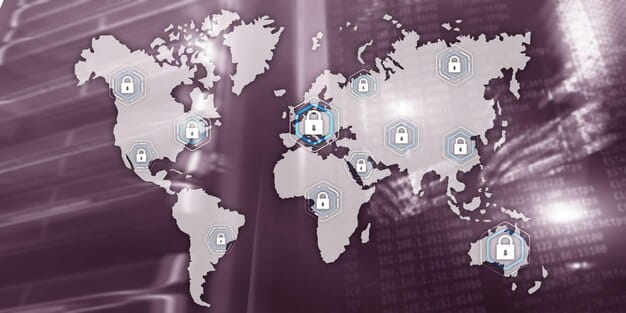Data Privacy Regulations: Your Compliance Guide for 2025

Data Privacy Regulations: Ensuring Compliance with the Latest Consumer Data Protection Laws involves understanding and adhering to evolving legal standards like GDPR and CCPA to protect consumer data and avoid penalties.
Navigating the complex landscape of Data Privacy Regulations: Ensuring Compliance with the Latest Consumer Data Protection Laws is crucial for businesses operating in the US. Keeping up-to-date with evolving regulations and implementing robust compliance strategies are key to safeguarding consumer data and maintaining trust.
Understanding the Shifting Sands of Data Privacy Regulations
Data privacy regulations are constantly evolving, posing a significant challenge for businesses. Keeping abreast of these changes and understanding their implications is essential for maintaining compliance and avoiding significant penalties.
The Global Landscape of Data Privacy Laws
Data privacy isn’t confined to a single nation; it’s a global concern. Understanding the international regulations that affect your business is paramount.
- General Data Protection Regulation (GDPR): This EU regulation sets a high standard for data protection, impacting any organization handling data of EU citizens, regardless of location.
- California Consumer Privacy Act (CCPA): As one of the most comprehensive state laws in the US, the CCPA grants California residents significant rights over their personal data.
- Other State Laws: With states like Virginia, Colorado, and Utah enacting their own comprehensive privacy laws, businesses must navigate a patchwork of regulations.
Key Principles of Data Privacy Regulations
Understanding the fundamental principles underlying these regulations is critical for building a robust compliance program. This goes beyond simply ticking boxes on a checklist.

- Transparency and Consent: Individuals have the right to know what data is being collected about them and how it will be used. Explicit consent is often required before data collection can begin.
- Data Minimization: Organizations should only collect data that is necessary for a specific purpose. Avoid collecting excessive or irrelevant information.
- Purpose Limitation: Data should only be used for the purpose for which it was collected. Using data for new or unrelated purposes requires additional consent.
Staying informed and adapting to the evolving regulatory landscape is not just about avoiding fines; it’s about building trust with your customers. By demonstrating a commitment to data privacy, you can enhance your brand reputation and gain a competitive advantage.
Building a Data Privacy Compliance Program: A Step-by-Step Guide
Establishing a robust data privacy compliance program involves several key steps, from assessing your current practices to implementing ongoing monitoring and training.
Conducting a Data Privacy Assessment
The first step is to understand your current data privacy posture. What data do you collect? Where is it stored? How is it used?
A thorough data privacy assessment will help you identify potential gaps in your compliance program and prioritize areas for improvement.
Implementing Data Privacy Policies and Procedures
Once you have a clear understanding of your data practices, you can begin developing and implementing comprehensive data privacy policies and procedures.
These policies should outline your commitment to data privacy and provide clear guidance to employees on how to handle personal data in accordance with applicable regulations.
Training Your Employees on Data Privacy Best Practices
Your employees are on the front lines of data privacy. Providing them with comprehensive training on data privacy best practices is crucial for preventing data breaches and ensuring compliance.

Consider regular training sessions, quizzes, and ongoing communication to keep data privacy top of mind for your employees.
Building a strong data privacy compliance program is an ongoing process. It requires continuous monitoring, adaptation, and a commitment to building a culture of data privacy within your organization.
The Role of Technology in Data Privacy Compliance
Technology plays a critical role in supporting data privacy compliance efforts. From data encryption to access controls, technology can help organizations protect personal data and demonstrate compliance with regulations.
Data Encryption: Protecting Data at Rest and in Transit
Data encryption is a fundamental security measure that protects data from unauthorized access. Encrypting data both at rest (stored on servers or devices) and in transit (being transmitted over networks) is essential for maintaining data privacy.
Strong encryption algorithms can render data unreadable to unauthorized parties, even if they gain access to the data.
Access Controls: Restricting Access to Sensitive Data
Implementing strict access controls is crucial for limiting access to sensitive data. Only authorized personnel should have access to personal data, and access should be granted on a need-to-know basis.
Regularly review and update access controls to ensure that they are aligned with current business needs and security best practices.
Data Loss Prevention (DLP) Tools: Preventing Data Breaches
DLP tools can help organizations prevent data breaches by monitoring data flow and identifying potential data leaks. These tools can be configured to block unauthorized data transfers and alert security personnel to suspicious activity.
- Network DLP: Monitors data in transit across the network.
- Endpoint DLP: Monitors data on individual devices, such as laptops and desktops.
- Cloud DLP: Monitors data stored in cloud environments.
By leveraging technology effectively, organizations can significantly enhance their data privacy posture and reduce the risk of data breaches.
Data Breach Response Planning: Preparing for the Inevitable
Despite best efforts, data breaches can still occur. Having a well-defined data breach response plan is crucial for minimizing the impact of a breach and complying with legal requirements.
Developing a Data Breach Response Plan
A data breach response plan should outline the steps you will take in the event of a data breach, from identifying the breach to notifying affected individuals and regulatory authorities.
The plan should be tested regularly through simulations and tabletop exercises to ensure its effectiveness.
Notifying Affected Individuals and Regulatory Authorities
Most data privacy regulations require organizations to notify affected individuals and regulatory authorities in the event of a data breach. The notification must include specific information about the breach, such as the type of data compromised and the steps taken to mitigate the damage.
Failure to provide timely and accurate notification can result in significant fines and penalties.
Learning from Data Breaches: Continuous Improvement
Every data breach is a learning opportunity. After a breach, conduct a thorough investigation to determine the root cause and identify areas for improvement in your data privacy program.
- Identify the vulnerability: What security weakness allowed the breach to occur?
- Implement corrective actions: What steps can be taken to prevent similar breaches in the future?
- Update the response plan: How can the data breach response plan be improved?
By learning from data breaches and continuously improving your data privacy program, you can reduce the risk of future incidents and demonstrate a commitment to protecting personal data.
The Impact of Data Privacy on Marketing and Advertising
Data privacy regulations have a significant impact on marketing and advertising practices. Organizations must obtain consent before collecting and using personal data for marketing purposes, and they must provide individuals with the ability to opt out of marketing communications.
Obtaining Consent for Marketing Activities
Before collecting and using personal data for marketing purposes, organizations must obtain explicit consent from individuals. This consent must be freely given, specific, informed, and unambiguous.
Pre-ticked boxes or implied consent are generally not sufficient under data privacy regulations.
Providing Opt-Out Options
Individuals must have the ability to opt out of marketing communications at any time. This opt-out option should be easy to find and use.
Organizations must honor opt-out requests promptly and ensure that individuals are no longer contacted for marketing purposes.
Transparency in Marketing Practices
Transparency is key to building trust with consumers. Organizations should be transparent about their marketing practices, including how they collect and use personal data.
- Clearly explain data usage: What data is collected and why?
- Provide a privacy policy: Make it easy for consumers to access and understand your privacy policy.
- Be upfront about targeted advertising: Disclose that you are using personal data to personalize ads.
Adapting marketing and advertising practices to comply with data privacy regulations is not just about avoiding legal risks; it’s about building stronger relationships with customers based on transparency and trust.
Future Trends in Data Privacy: Preparing for What’s Next
The field of data privacy is constantly evolving. Staying ahead of emerging trends is crucial for maintaining compliance and building a future-proof data privacy program.
Increased Enforcement of Data Privacy Regulations
Regulatory authorities are increasing their enforcement of data privacy regulations, and organizations that fail to comply face significant fines and penalties.
Expect to see more investigations, audits, and enforcement actions in the years to come.
The Rise of Privacy-Enhancing Technologies (PETs)
Privacy-enhancing technologies (PETs) are emerging as a promising solution for protecting personal data while still enabling valuable data analysis. These technologies include:
- Differential Privacy: Adds noise to data to protect individual identities.
- Homomorphic Encryption: Allows data to be processed without being decrypted.
- Secure Multi-Party Computation: Enables multiple parties to analyze data without revealing their individual datasets.
Consumers Demanding Greater Control Over Their Data
Consumers are increasingly demanding greater control over their personal data. They want to know what data is being collected about them, how it is being used, and who it is being shared with.
Organizations that empower consumers with greater control over their data will be better positioned to build trust and loyalty.
| Key Aspect | Brief Description |
|---|---|
| 🛡️ GDPR Compliance | Adhering to EU’s GDPR for data protection of EU citizens worldwide. |
| 🔑 CCPA Compliance | Following California’s CCPA to give consumers control over their personal data. |
| 🔒 Data Encryption | Protecting data both in storage and during transit using strong encryption methods. |
| 🚨 Breach Response | Having a clear plan to tackle data breaches by informing people at risk quickly. |
Frequently Asked Questions
▼
Data privacy regulations are laws and guidelines that dictate how personal data should be collected, used, stored, and shared, with the goal of protecting individuals’ privacy rights.
▼
GDPR, or General Data Protection Regulation, is a European Union law that governs the processing of personal data of individuals within the EU, regardless of the company’s location.
▼
CCPA, or California Consumer Privacy Act, is a California law that grants consumers in California various rights regarding their personal data, including the right to know, delete, and opt-out.
▼
Data privacy is vital as it ensures individuals have control over their personal information, prevents identity theft, safeguards sensitive data, and promotes ethical business practices.
▼
Businesses can ensure data privacy compliance by conducting regular data assessments, implementing robust security measures, training employees, and staying updated with the latest regulatory changes.
Conclusion
Staying ahead of the curve in data privacy regulations is not merely about legal compliance; it’s about building trust and demonstrating a commitment to ethical data handling. As regulations continue to evolve, a proactive approach, strong technological safeguards, and a culture of data privacy are crucial for businesses to thrive in an increasingly data-driven world.





